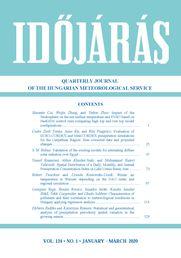IDŐJÁRÁS - angol nyelvű folyóirat
Vol. 124, No. 1 * Pages 1–141 * January - March 2020
 |
|
 letöltés [pdf: 24504 KB]
letöltés [pdf: 24504 KB]
Impact of the stratosphere on the sea surface temperature and ENSO based on HadGEM control runs comparing high top and low top model configurations
Shaomin Cai, Weijia Zhang, and Yizhou Zhao
DOI:10.28974/idojaras.2020.1.1 (pp. 1–23)
Shaomin Cai, Weijia Zhang, and Yizhou Zhao
DOI:10.28974/idojaras.2020.1.1 (pp. 1–23)
IDŐJÁRÁS folyóirat

Az IDŐJÁRÁS a HungaroMet Nonprofit Zrt. negyedévenként megjelenő angol nyelvű folyóirata
Megrendelhető a journal.idojaras@met.hu címen.
A szerzőknek szánt útmutató itt olvasható.
Megrendelhető a journal.idojaras@met.hu címen.
A szerzőknek szánt útmutató itt olvasható.









